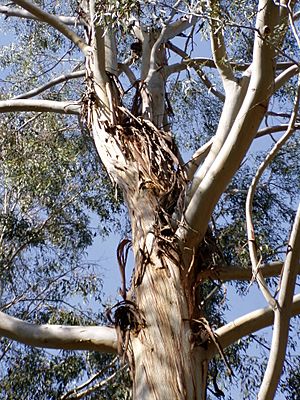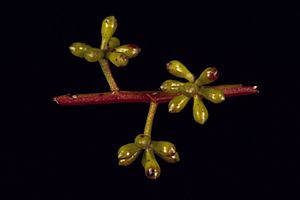Camden white gum facts for kids
Quick facts for kids Camden white gum |
|
|---|---|
 |
|
| Conservation status | |
| Scientific classification | |
| Genus: |
Eucalyptus
|
| Species: |
benthamii
|
The Camden white gum (scientific name: Eucalyptus benthamii) is a special type of tree. It is also known as Bentham's gum or Nepean River gum. This tree is found only in New South Wales, Australia.
It has smooth bark that is usually bluish-grey or white. Its leaves are long and shaped like a spear. The flowers are white and grow in groups of seven. After flowering, it produces small, woody fruits.
Contents
What is the Camden White Gum Like?
The Camden white gum is a very tall tree. It can grow up to 35 to 40 metres (about 115 to 130 feet) high. Its trunk can be as wide as 1.5 metres (about 5 feet) across!
Most of its bark is smooth and peels off in long strips. It is usually bluish-grey or white. But at the bottom of the trunk, there's about 1 metre (3 feet) of rough, brownish bark.
Leaves and Flowers
Young Camden white gum trees have heart-shaped leaves. These leaves grow in pairs and are directly attached to the stem. They are about 30 to 90 mm (1 to 3.5 inches) long.
Adult trees have longer, spear-shaped leaves. They are about 80 to 230 mm (3 to 9 inches) long. These leaves have a small stalk, called a petiole, that connects them to the branch.
The tree's flower buds grow in groups of seven. Each group is on a short stalk about 4 to 8 mm long. The buds themselves are oval-shaped and have a rounded cap.
Camden white gum trees flower between March and September. Their flowers are always white. After the flowers, small, woody fruits appear. These fruits are shaped like a cup, bell, or cone. They are about 3 to 4 mm long.
How Did It Get Its Name?
The Camden white gum was first officially described in 1915. Two scientists, Joseph Maiden and Richard Hind Cambage, gave it its scientific name, Eucalyptus benthamii.
They found a sample of the tree near the Nepean River in a place called Cobbity. The name benthamii is thought to be in honour of a famous botanist named George Bentham.
Where Does It Grow?
The Camden white gum grows in special places called alluvial plains. These are flat areas near rivers where the soil is rich. It likes sandy or loamy soil over clay.
You can find it along the Nepean River and its smaller streams. It often grows in tall, open forests. Sometimes, it forms its own group of trees. Other times, it grows with other types of gum trees.
Some of its tree neighbours include the mountain blue gum and river peppermint. Other trees like grey box and forest red gum also grow nearby.
Smaller plants and shrubs grow under these tall trees. These include blackthorn, bracken fern, and fern-leaved wattle.
Protecting This Tree
The Camden white gum is considered a "vulnerable" species. This means it is at risk of disappearing. Both the Australian Government and the New South Wales Government have laws to protect it.
Most of these trees are found in two main areas. One is near the Kedumba River in the Blue Mountains National Park. The other is at Bents Basin State Conservation Area near Wallacia.
There are also a few scattered trees around Camden and Cobbity. Experts believe there are about 10,000 trees at Kedumba. However, only about 400 are left at Bents Basin.
Sadly, many Camden white gum trees were lost when land was cleared. Also, the creation of Warragamba Dam flooded much of the area where they used to grow. This has greatly reduced their numbers.
How People Use This Tree
The Camden white gum grows quickly and can adapt to different conditions. Because of this, people are studying it in places like South Africa and South America. They are looking into using it for pulpwood plantations. This means growing the trees to produce wood pulp, which is used to make paper.





